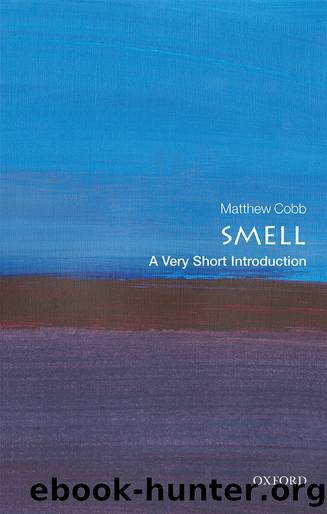Smell: A Very Short Introduction by Matthew Cobb

Author:Matthew Cobb [Cobb, Matthew]
Language: eng
Format: epub
Tags: Science
ISBN: 9780192559012
Google: 5snhDwAAQBAJ
Amazon: B0851NQ7F2
Publisher: Oxford University Press
Published: 2020-05-14T23:00:00+00:00
Navigation
These complex links between place, memory, and smell may be explained by an idea first put forward in 2012, by Lucia Jacobs of the University of California. She suggested that in all animals a primary function of olfaction is navigation. Jacobsâs starting point was our difficulty in understanding why the size of the olfactory bulb in vertebrates does not always scale with the rest of the brain; associated structures, such as the hippocampus, also show this effect. The explanation may lie in ecology: a study of 146 species of terrestrial carnivorous mammal revealed that the relative size of the olfactory bulb is positively correlated with the speciesâ home range sizeâthe larger the area the animal normally covers in searching for food, the larger its olfactory bulb compared to the rest of its brain. Jacobs argued that the brain anatomy of different species with different foraging strategies also supported her hypothesis, and other researchers have adopted her framework in an attempt to understand the evolution of the vertebrate brain. The underlying explanation may be that the size of the olfactory bulb is directly related to the number of olfactory neurons, which in turn will relate to the ecology of the animal and the distance at which it detects odours.
Whatever the truth of Jacobsâs hypothesis, olfaction is involved in animal navigation on both local and global scales. Pigeons can return to their loft even if they were released hundreds of kilometres away, and although the stars, visual landmarks, and even the Earthâs magnetic field have been implicated in this ability, the sense of smell plays a fundamental role, in particular when the bird is only a few dozen kilometres from home. Scientists in Italy showed that pigeons with a damaged olfactory system were much less likely to return to the loft than those that were intact, while researchers in Germany mapped out the distribution of various odours around their laboratory in Würzburg, showing that what they called the olfactory landscape contained sufficient variation to account for the birdsâ homing ability.
Sea-faring birds such as shearwaters will return to their home burrow after foraging for days on end over the ocean. Researching the behaviour of such wild animals is challenging, but a number of studies have shown that birds with damaged olfactory systems cannot find their way home, and that most flights by three different species of shearwater involved olfactory-guided navigation (Figure 17). Members of the closely related species, the nocturnal blue petrel, which return to their burrow at night, also use smell to find their way home.
17. Homing orientation of shearwaters on returning from deep-sea foraging. An angle of 0° represents a straight line to the nest. C = control birds, with no manipulation; M = birds with a magnet on their head, to disrupt any use of magnetic information; A = anosmic birds with no olfactory system. Between 12 and 14 birds were studied in each group.
Download
This site does not store any files on its server. We only index and link to content provided by other sites. Please contact the content providers to delete copyright contents if any and email us, we'll remove relevant links or contents immediately.
| Administration & Medicine Economics | Allied Health Professions |
| Basic Sciences | Dentistry |
| History | Medical Informatics |
| Medicine | Nursing |
| Pharmacology | Psychology |
| Research | Veterinary Medicine |
Machine Learning at Scale with H2O by Gregory Keys | David Whiting(4183)
Fairy Tale by Stephen King(3220)
Will by Will Smith(2793)
Hooked: A Dark, Contemporary Romance (Never After Series) by Emily McIntire(2502)
Rationality by Steven Pinker(2291)
Friends, Lovers, and the Big Terrible Thing by Matthew Perry(2119)
The Becoming by Nora Roberts(2088)
Love on the Brain by Ali Hazelwood(1965)
HBR's 10 Must Reads 2022 by Harvard Business Review(1777)
The Strength In Our Scars by Bianca Sparacino(1776)
A Short History of War by Jeremy Black(1762)
Leviathan Falls (The Expanse Book 9) by James S. A. Corey(1651)
515945210 by Unknown(1599)
A Game of Thrones (The Illustrated Edition) by George R. R. Martin(1589)
Bewilderment by Richard Powers(1539)
443319537 by Unknown(1470)
The 1619 Project by Unknown(1387)
The Real Anthony Fauci: Bill Gates, Big Pharma, and the Global War on Democracy and Public Health (Childrenâs Health Defense) by Robert F. Kennedy(1366)
Fear No Evil by James Patterson(1278)
